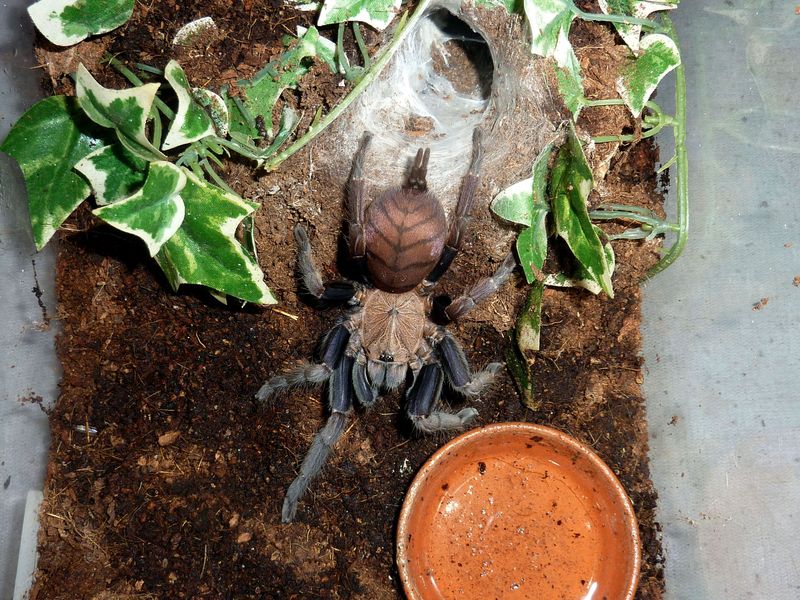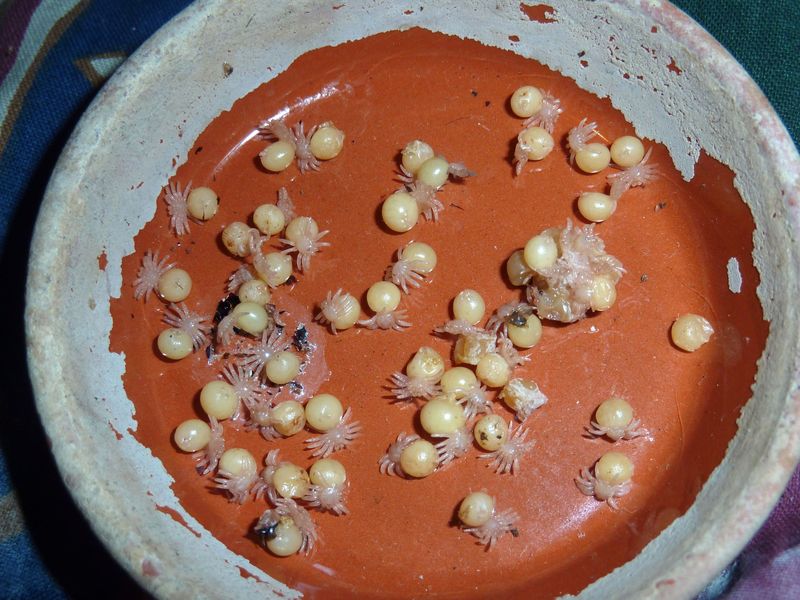- Joined
- Jan 30, 2012
- Messages
- 3,797
In the past, I've now and then made a thread about a certain species with some basic information on them, behavior, how I keep and the like. Today, it'll be about an old-world burrowing species: Chilobrachys fimbriatus
General Information:
First described by Pocock 1899 the phenotype was reportedly from the area around Khamala. They can be found in burrows dug into the road embankments in their natural habitat. You can find a climate diagram HERE - this one is using celsius, not fahrenheit!.
The species is quite colorful, showing off beautiful markings on the abdomen and sporting violet / blueish femurs as adult. Spiderlings are plain brown, but from around ~2.5" onward start to develop the colorful femurs and rest of their markings quickly. Depending on the angle of light, the do look a little blueish on the legs and reddish on the abdomen already as tiny spreckles. Mature males reach around ~5" legspan and have no tibial spurs (hooks) on the legs (bulbous pedipalps still dead giveaway) and their femur coloration is more black than violet once mature, whereas females supposedly can get even up to 7" (personally never seen a specimen that big and hence doubting it) with most being in the 6" range. Pretty fast growers, too!
How to keep:
These prefer damp (not swampy!) substrate being an asian burrower. However, letting it dry it out completely (as it does happen in their natural habitat) for a few weeks won't harm them. An always filled waterdish should be provided as they will make use of it just like any other tarantula. 6"+ of substrate is the least they should be provided with, I think. Personally, I'm using simple cocofiber currently, but i did use eco-earth before that and both choice were accepted by both of my specimens. As burrowers providing them with a starter burrow helps, but some are quite opportunistic and will just construct huge (very sticky!) webcastles instead (or in addition!). Overall, these seemingly web as much (I dare say more even...) than your typical GBB, which I think is making them very unique. Temperature-wise they do well around 22-28°C wheras during summer my room gets up to 30°C with no negative observations.
Temperament / Toxicity:
Keep in mind, these are old-world. No urticating hairs, but their bite packs a punch! Venom strength reportedly ranges around Poecilotheria with symptoms including high fever, vomitting, muscle cramps, intense pain, swelling, profuse sweating and the like able to last for weeks just like their arboreal cousins venom. Certainly not a species to mess with either, as these are incredibly fast and quick to react. An article in the ARACHNE stated that these have the ability to turn 180° without giving any indication prior to on the slightest feel of movement - so keep hands well out of reach as I can attest to that 1st hand! From own observations having raised my couple from spiderlings to adults, I'd say they are mellowing out some as adults, but nowhere near the point where you could trust them to work withou tools in their cages. Defensive responses consist of three options I've witnessed: 1) Frantically run around the cage, with high chances of escape seemingly panicking, 2) vanishing into their burrow, or 3) immediate confrontation with threatposing and bites. For the most part, if disturbed while outside their burrow, mine will just hide immediately and won't show up until the disturbance is gone again. Exception being they shoot right back out if something touches the mound of their burrow!
Great -voracious- eaters, molts are getting stored inside their burrow usually and thrown out at their leisure if at all. Given their venom strenght and incredible speed, they should be treated like any other high-strung OW tarantula with lots of respect, but no fear. Personally I've never regretted getting these are my entry into the OWs, as they are really easy to care for once in their final enclosure. That being said, rehousing them can be challenge if you're worried - catchup, tongs are mandatory! I've had a couple rehousings that were difficult, both with the male. The most the female did was threaten a number of times, slap with fangs bared and stridulate - but she was pretty cooperative overall going where I wanted her to. The male constantly turned to face the tool used to prod him into the catchcup and tried multiple times to climb the tongs, at which point I abandoned that and used a soft straw instead to prod him with. All in kept in mind, once in the final enclosure, they're usually out at night checking their digs, webbing like crazy or at the least sitting at the mound of their burrow. My own, biased, opinion: Awesome species!
Bottom line:
Not a species I'd ever suggest to the hands of someone just entering the hobby, except if I'd know and trust the person. Although I myself am somewhat wary of Haploplema spp. I decided to get these because of looks and experience I had gathered back when I got them. They are easy enough to care for if one follows strict policies of not messing unnessarily with them, having catchcup always in range and not reaching into their cages with bare hands. Rehousing can be challenging, but works just the same way as with any other high-strung species. In my opinion a great, pretty fast growing OW with awesome looks and a GBB-like webbing skill on top of that. Anyone with experience with fast moving, agile arboreals or other OW species will find these a great addition to their collection.
Pictures:
Spiderling ~0.5"

Juvenile, ~3"

My mature male, "Ares", ~5"

My mature female, "Hera", ~6"

Gravid female "Hera", ~6"

EWLs (sac went bad sadly)

Perhaps this short rundown of them will help a few people decide if, or if not, to add them to their collection. If you have anything to add, feel free to do so and in case you find errors correcting them is appreciated, too
Best
~Jan
General Information:
First described by Pocock 1899 the phenotype was reportedly from the area around Khamala. They can be found in burrows dug into the road embankments in their natural habitat. You can find a climate diagram HERE - this one is using celsius, not fahrenheit!.
The species is quite colorful, showing off beautiful markings on the abdomen and sporting violet / blueish femurs as adult. Spiderlings are plain brown, but from around ~2.5" onward start to develop the colorful femurs and rest of their markings quickly. Depending on the angle of light, the do look a little blueish on the legs and reddish on the abdomen already as tiny spreckles. Mature males reach around ~5" legspan and have no tibial spurs (hooks) on the legs (bulbous pedipalps still dead giveaway) and their femur coloration is more black than violet once mature, whereas females supposedly can get even up to 7" (personally never seen a specimen that big and hence doubting it) with most being in the 6" range. Pretty fast growers, too!
How to keep:
These prefer damp (not swampy!) substrate being an asian burrower. However, letting it dry it out completely (as it does happen in their natural habitat) for a few weeks won't harm them. An always filled waterdish should be provided as they will make use of it just like any other tarantula. 6"+ of substrate is the least they should be provided with, I think. Personally, I'm using simple cocofiber currently, but i did use eco-earth before that and both choice were accepted by both of my specimens. As burrowers providing them with a starter burrow helps, but some are quite opportunistic and will just construct huge (very sticky!) webcastles instead (or in addition!). Overall, these seemingly web as much (I dare say more even...) than your typical GBB, which I think is making them very unique. Temperature-wise they do well around 22-28°C wheras during summer my room gets up to 30°C with no negative observations.
Temperament / Toxicity:
Keep in mind, these are old-world. No urticating hairs, but their bite packs a punch! Venom strength reportedly ranges around Poecilotheria with symptoms including high fever, vomitting, muscle cramps, intense pain, swelling, profuse sweating and the like able to last for weeks just like their arboreal cousins venom. Certainly not a species to mess with either, as these are incredibly fast and quick to react. An article in the ARACHNE stated that these have the ability to turn 180° without giving any indication prior to on the slightest feel of movement - so keep hands well out of reach as I can attest to that 1st hand! From own observations having raised my couple from spiderlings to adults, I'd say they are mellowing out some as adults, but nowhere near the point where you could trust them to work withou tools in their cages. Defensive responses consist of three options I've witnessed: 1) Frantically run around the cage, with high chances of escape seemingly panicking, 2) vanishing into their burrow, or 3) immediate confrontation with threatposing and bites. For the most part, if disturbed while outside their burrow, mine will just hide immediately and won't show up until the disturbance is gone again. Exception being they shoot right back out if something touches the mound of their burrow!
Great -voracious- eaters, molts are getting stored inside their burrow usually and thrown out at their leisure if at all. Given their venom strenght and incredible speed, they should be treated like any other high-strung OW tarantula with lots of respect, but no fear. Personally I've never regretted getting these are my entry into the OWs, as they are really easy to care for once in their final enclosure. That being said, rehousing them can be challenge if you're worried - catchup, tongs are mandatory! I've had a couple rehousings that were difficult, both with the male. The most the female did was threaten a number of times, slap with fangs bared and stridulate - but she was pretty cooperative overall going where I wanted her to. The male constantly turned to face the tool used to prod him into the catchcup and tried multiple times to climb the tongs, at which point I abandoned that and used a soft straw instead to prod him with. All in kept in mind, once in the final enclosure, they're usually out at night checking their digs, webbing like crazy or at the least sitting at the mound of their burrow. My own, biased, opinion: Awesome species!
Bottom line:
Not a species I'd ever suggest to the hands of someone just entering the hobby, except if I'd know and trust the person. Although I myself am somewhat wary of Haploplema spp. I decided to get these because of looks and experience I had gathered back when I got them. They are easy enough to care for if one follows strict policies of not messing unnessarily with them, having catchcup always in range and not reaching into their cages with bare hands. Rehousing can be challenging, but works just the same way as with any other high-strung species. In my opinion a great, pretty fast growing OW with awesome looks and a GBB-like webbing skill on top of that. Anyone with experience with fast moving, agile arboreals or other OW species will find these a great addition to their collection.
Pictures:
Spiderling ~0.5"

Juvenile, ~3"
My mature male, "Ares", ~5"

My mature female, "Hera", ~6"

Gravid female "Hera", ~6"

EWLs (sac went bad sadly)

Perhaps this short rundown of them will help a few people decide if, or if not, to add them to their collection. If you have anything to add, feel free to do so and in case you find errors correcting them is appreciated, too
Best
~Jan
